CHEVROLET BLAZER 1994 2.G Manual PDF
Manufacturer: CHEVROLET, Model Year: 1994, Model line: BLAZER, Model: CHEVROLET BLAZER 1994 2.GPages: 348, PDF Size: 17.88 MB
Page 71 of 348
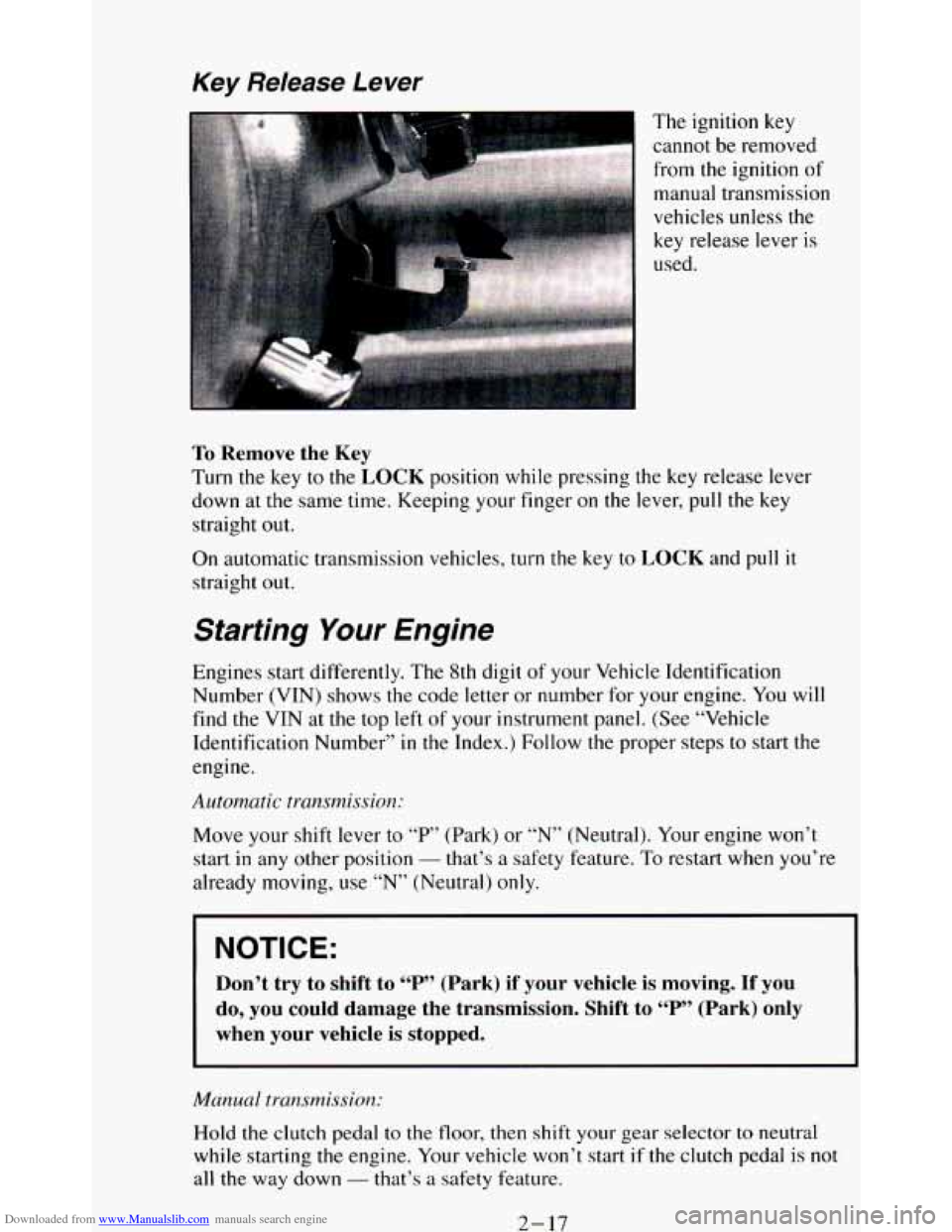
Downloaded from www.Manualslib.com manuals search engine Key Release Lever
I The ignition key
cannot be removed
from the ignition
of
manual transmission
vehicles unless the
key release lever
is
used.
To Remove the Key
Turn the key to the LOCK position while pressing the key release lever
down at the same time. Keeping your finger on the lever,
pull the key
straight
out.
On automatic transmission vehicles, turn the key to LOCK and pull it
straight out.
Starting Your Engine
Engines start differently. The 8th digit of your Vehicle Identification
Number (VIN) shows the code letter or number for your engine. You will
find the VIN at the top left of your instrument panel. (See “Vehicle
Identification Number” in the Index.) Follow the proper steps to start the
engine.
Automatic transmission:
Move your shift lever to “P” (Park) or “N” (Neutral). Your engine won’t
start
in any other position - that’s a safety feature. To restart when you’re
already moving, use “N” (Neutral)
only.
NOTICE:
Don’t try to shift to “P” (Park) if your vehicle is moving. If you
do, you could damage the transmission. Shift to “P” (Park) only
when your vehicle is stopped.
Manual transmission:
Hold the clutch pedal to the floor, then shift your gear selector to neutral
while starting
the engine. Your vehicle won’t start if the clutch pedal is not
all the way down - that’s a safety feature.
2-17
Page 72 of 348
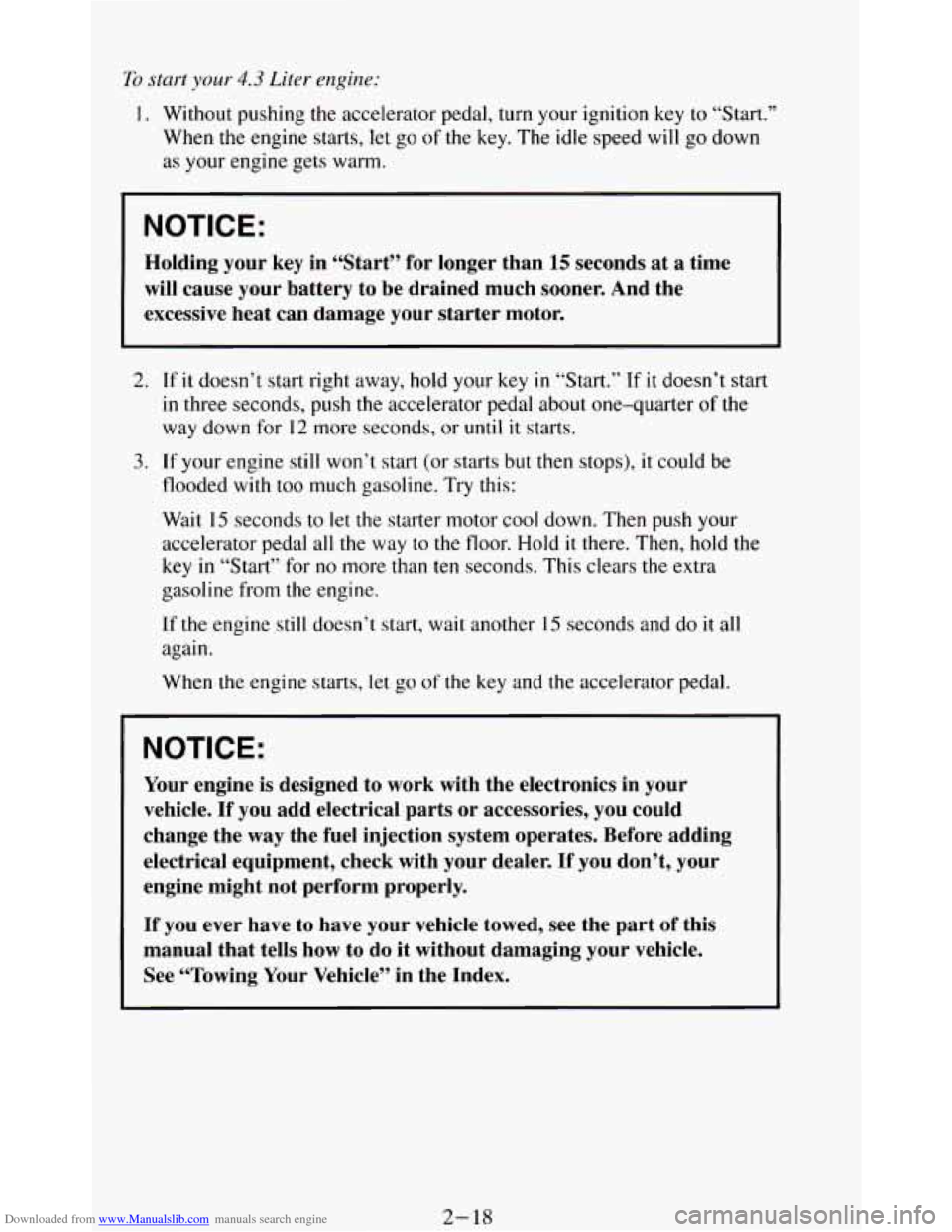
Downloaded from www.Manualslib.com manuals search engine Tu start your 4.3 Liter engine:
1. Without pushing the accelerator pedal, turn your ignition key to “Start.”
When
the engine starts, let go of the key. The idle speed will go down
as your engine gets warm.
NOTICE:
Holding your key in “Start” for longer than 15 seconds at a time
will cause your battery to be drained much sooner. And the
excessive heat can damage your starter motor.
2. If it doesn’t start right away, hold your key in “Start.” If it doesn’t start
in three seconds, push the accelerator pedal about one-quarter of the
way down for
12 more seconds, or until it starts.
3. If your engine still won’t start (or starts but then stops), it could be
flooded with too much gasoline. Try this:
Wait
15 seconds to let the starter motor cool down. Then push your
accelerator pedal all the way to the floor. Hold it there. Then, hold the
key
in “Start” for no more than ten seconds. This clears the extra
gasoline from the engine.
If the engine still doesn’t start, wait another 15 seconds and do it all
again..
When
the engine starts, let go of the key and the accelerator pedal.
j ~ NOTICE:
, Your engine is designed to work with the electronics in your
vehicle. If you add electrical parts
or accessories, you could
change the
way the fuel injection system operates. Before adding
electrical equipment, check with your dealer. If you don’t, your
engine might not perform properly.
If you ever have to have your vehicle towed, see the part of this
manual that tells how
to do it without damaging your vehicle.
See “Towing Your Vehicle” in the Index.
2- 18
Page 73 of 348
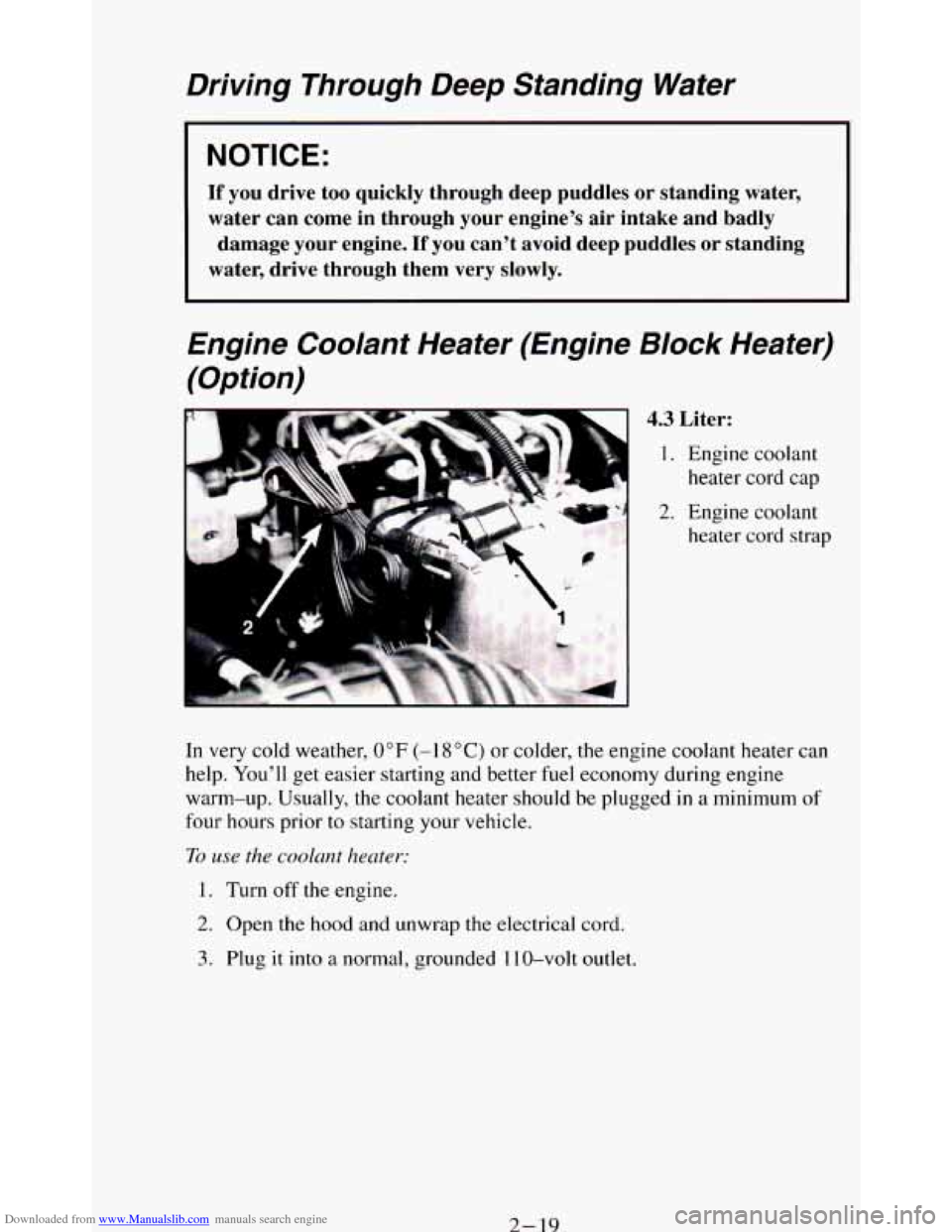
Downloaded from www.Manualslib.com manuals search engine Driving Through Deep Standing Water
NOTICE:
If you drive too quickly through deep puddles or standing water,
water can come in through your engine's air intake and badly damage your engine.
If you can't avoid deep puddles or standing
water, drive through them very slowly.
Engine Coolant Heater (Engine Block Heater)
(Option)
4.3 Liter:
I. Engine coolant
heater cord cap
2. Engine coolant
heater cord strap
In very cold weather,
0°F (- 18 "C) or colder, the engine coolant heater can
help. You'll get easier starting and better fuel economy during engine
warm-up. Usually, the coolant heater should be plugged in a minimum
of
four hours prior to starting your vehicle.
To use the coolunt heater:
1. Turn off the engine.
2. Open the hood and unwrap the electrical cord.
3. Plug it into a normal, grounded 1 10-volt outlet.
2-19
Page 74 of 348
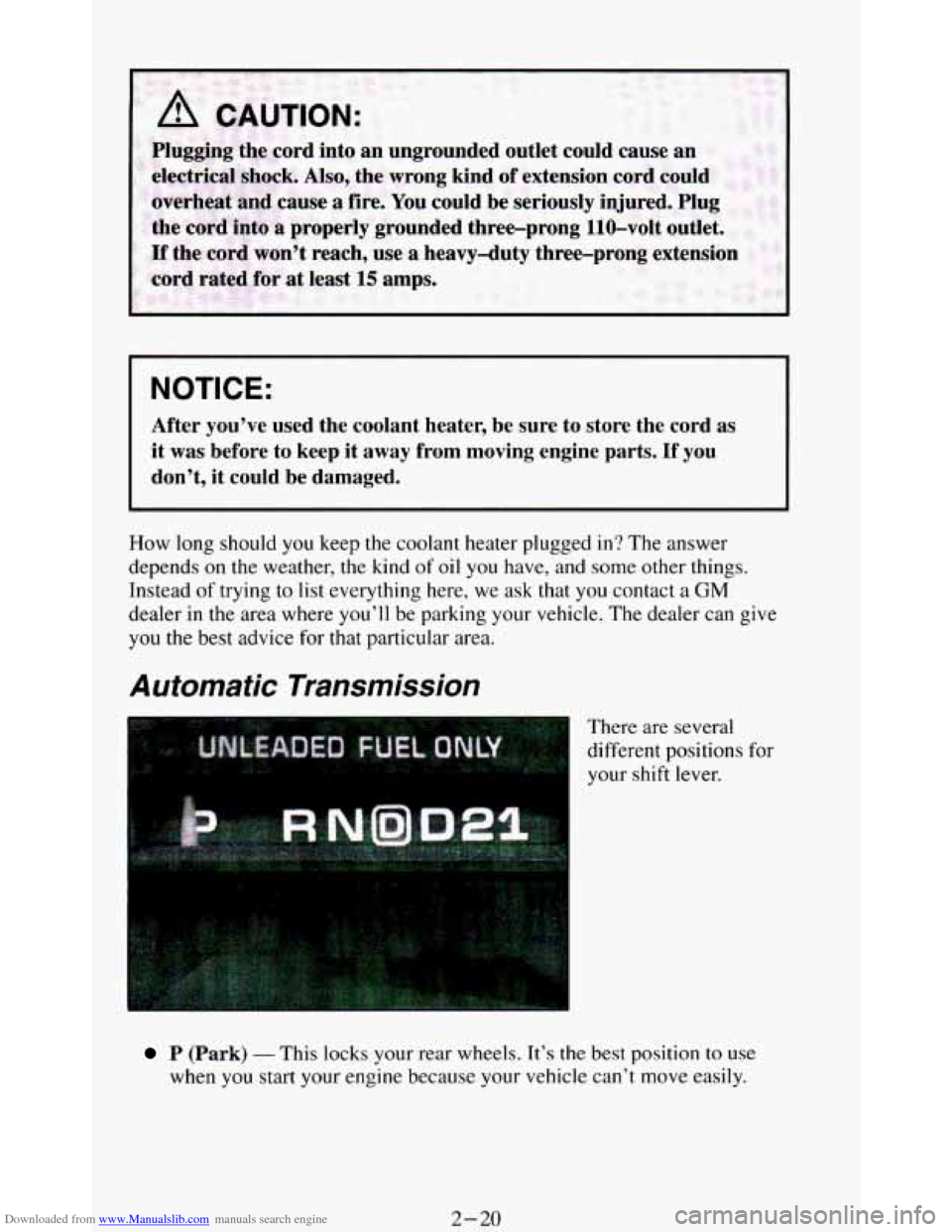
Downloaded from www.Manualslib.com manuals search engine NOTICE:
After you’ve used the coolant heater, be sure to store the cord as
it was before to keep
it away from moving engine parts. If you
don’t,
it could be damaged.
How long should you keep the coolant heater plugged in? The answer
depends
on the weather, the kind of oil you have, and some other things.
Instead
of trying to list everything here, we ask that you contact a GM
dealer in the area where you’ll be parking your vehicle. The dealer can give
you the best advice for that particular area.
Automatic Transmission
.. . ...
There are several
different positions for
your shift lever.
P (Park) - This locks your rear wheels. It’s the best position to use
when you start your engine because your vehicle can’t move easily.
2-20
Page 75 of 348
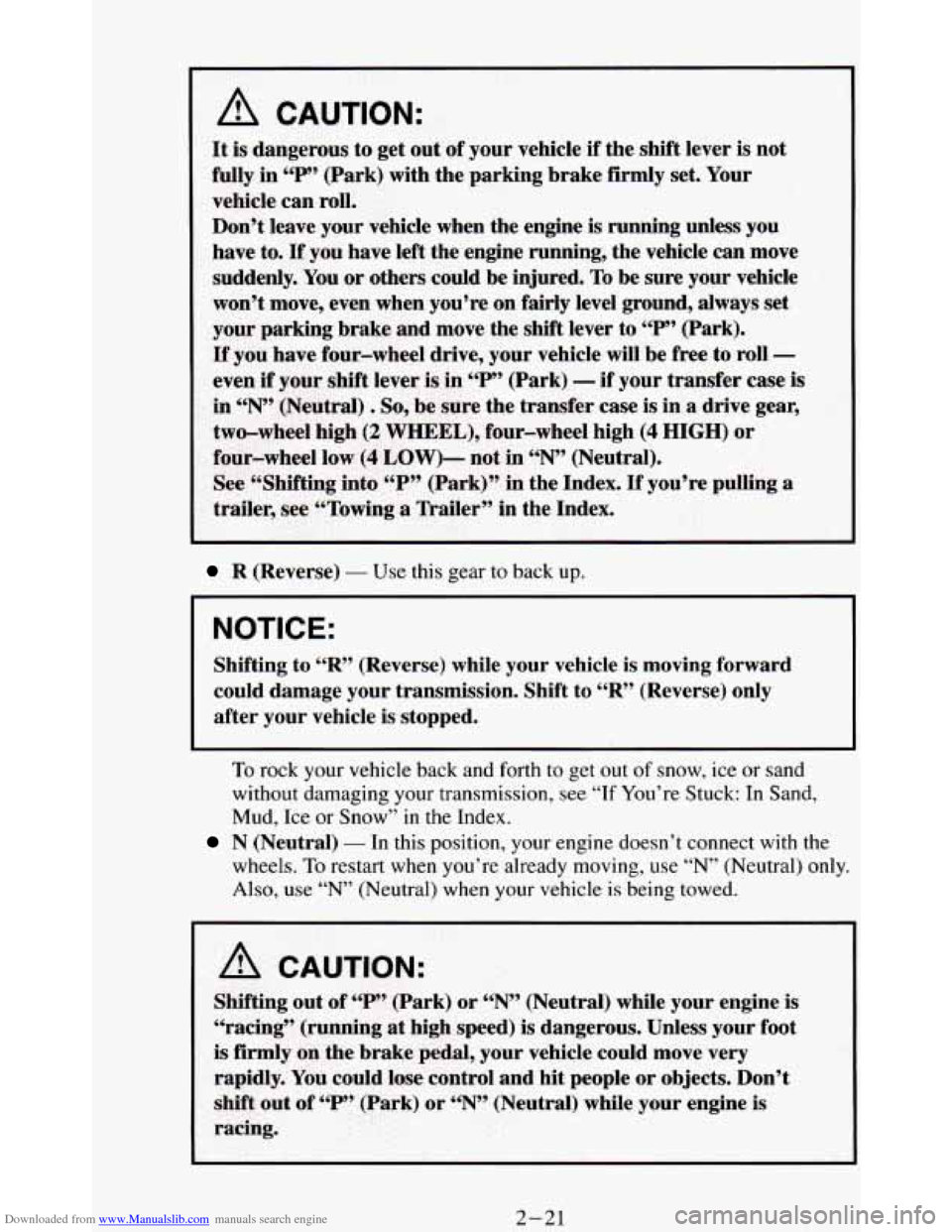
Downloaded from www.Manualslib.com manuals search engine 1
R (Reverse) - Use this gear to back up.
NOTICE:
Shifting to “R” (Reverse) while your vehicle is moving forward
could damage your transmission. Shift to
“R” (Reverse) only
after your vehicle
is stopped.
To rock your vehicle back and forth to get out of snow, ice or sand
without damaging your transmission, see
“If You’re Stuck: In Sand,
Mud, Ice or Snow”
in the Index.
N (Neutral) - In this position, your engine doesn’t connect with the
wheels.
To restart when you’re already moving, use “N” (Neutral) only.
Also, use
“N’ (Neutral) when your vehicle is being towed.
2-21
Page 76 of 348
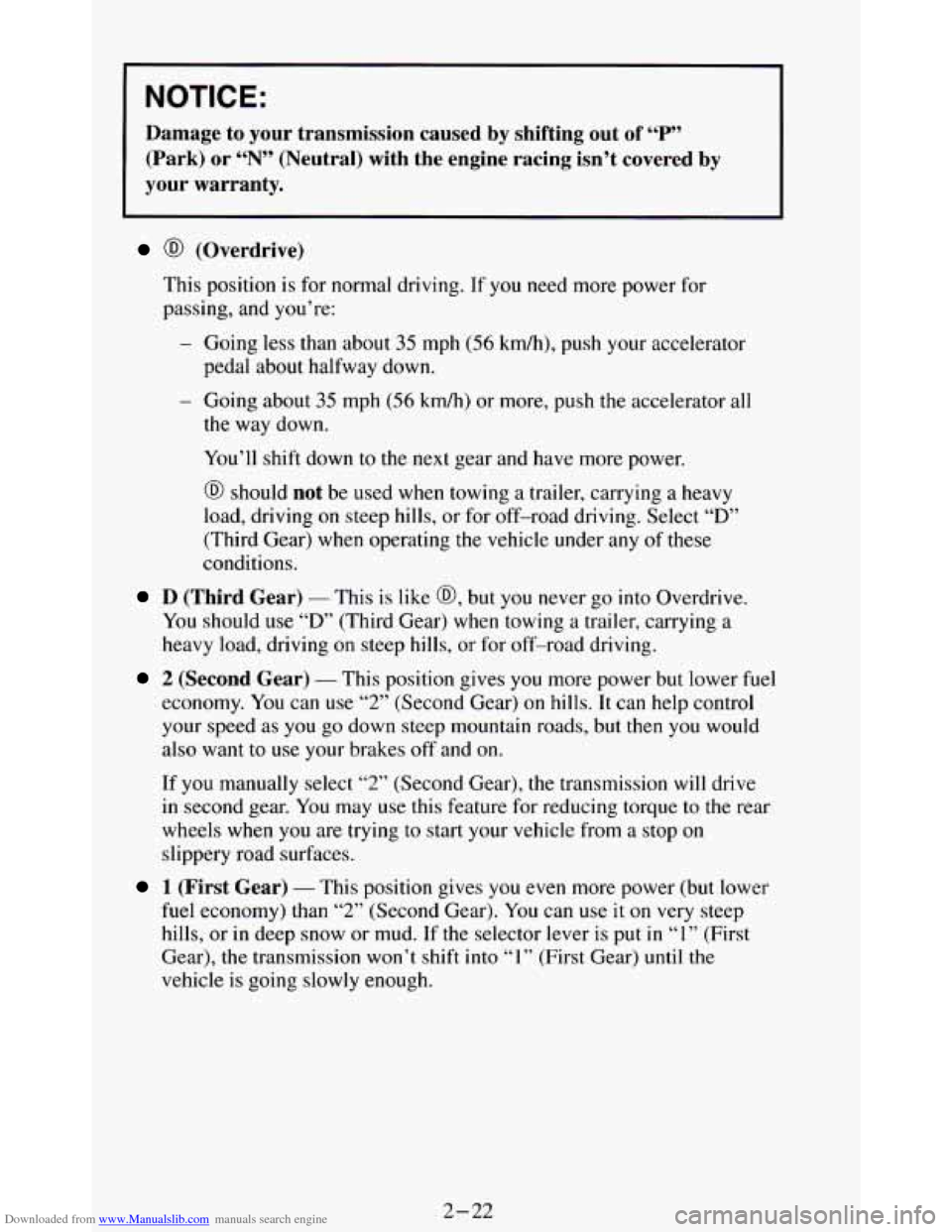
Downloaded from www.Manualslib.com manuals search engine NOTICE:
Damage to your transmission caused by shifting out of “P”
(Park) or “N” (Neutral) with the engine racing isn’t covered by
your warranty.
@ (Overdrive)
This position is for normal driving. If you need more power for
passing, and you’re:
- Going less than about 35 mph (56 km/h), push your accelerator
- Going about 35 mph (56 km/h) or more, push the accelerator all
pedal about halfway down.
the way down.
You’ll shift down to the next gear and have more power.
@ should not be used when towing a trailer, carrying a heavy
load, driving
on steep hills, or for off-road driving. Select “D”
(Third Gear) when operating the vehicle under any of these
conditions.
D (Third Gear) - This is like @, but you never go into Overdrive.
You should use
“D’ (Third Gear) when towing a trailer, carrying a
heavy load, driving on steep hills,
or for off-road driving.
2 (Second Gear) - This position gives you more power but lower fuel
economy. You can use “2” (Second Gear) on hills. It can help control
your speed as you go down steep mountain roads, but
then you would
also want to use your brakes
off and on.
If you manually select
“2” (Second Gear), the transmission will drive
in second gear. You may use this feature for reducing torque to the rear
wheels when
you are trying to start your vehicle from a stop on
slippery road surfaces.
1 (First Gear) - This position gives you even more power (but lower
fuel economy) than “2” (Second Gear). You can use it on very steep
hills, or in deep snow or mud. If the selector lever is put
in “1” (First
Gear),
the transmission won’t shift into “1” (First Gear) until the
vehicle
is going slowly enough.
2-22
Page 77 of 348
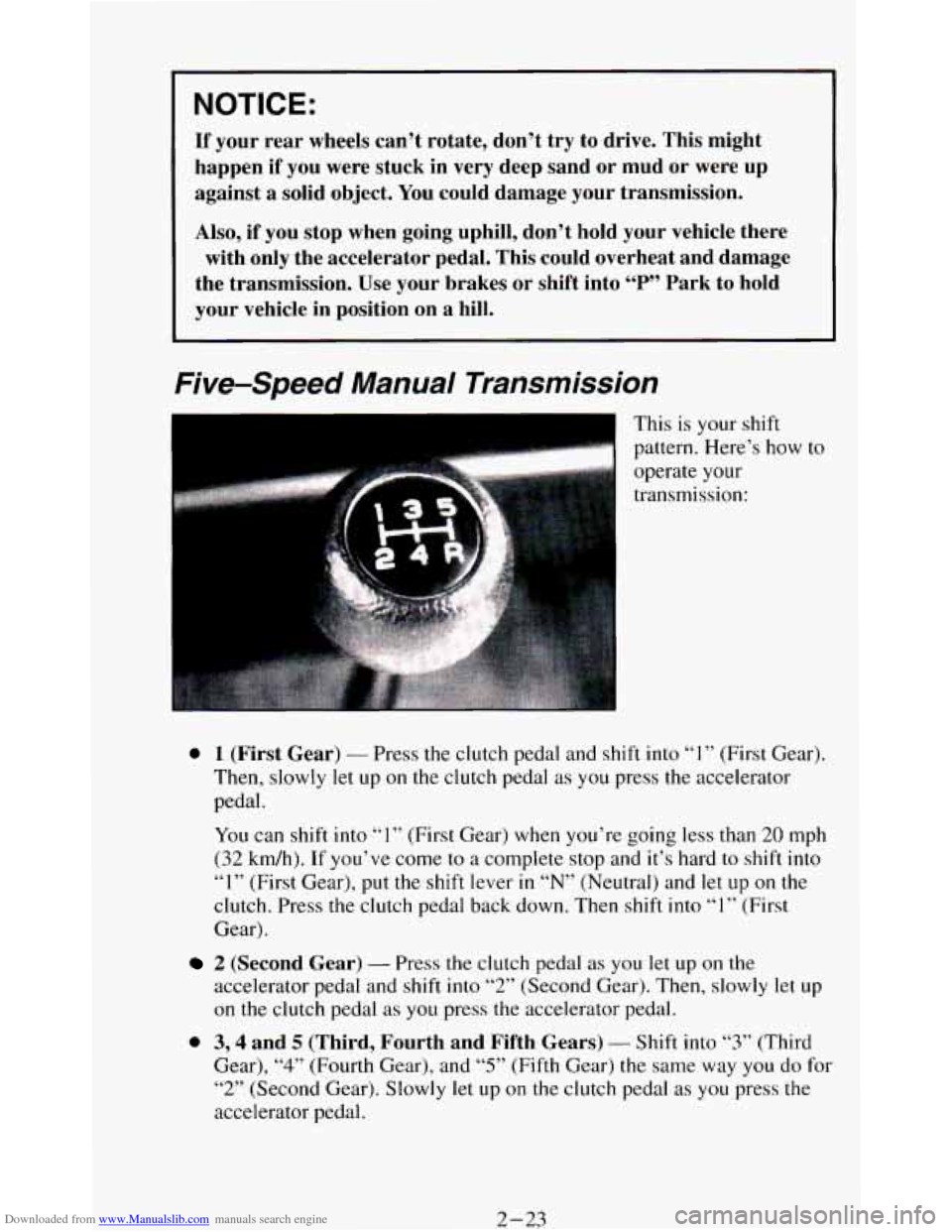
Downloaded from www.Manualslib.com manuals search engine If your rear wheels can’t rotate, don’t try to drive. This might
happen if you were stuck in very deep sand or mud or were up
against a solid object. You could damage your transmission.
Also, if you stop when going uphill, don’t hold your vehicle there
with only the accelerator pedal. This could overheat and damage
the transmission. Use your brakes
or shift into “P” Park to hold
your vehicle in position on a hill.
Five-Speed Manual Transmission
This is your shift
pattern. Here’s how
to 1..
operate your
transmission:
0 1 (First Gear) - Press the clutch pedal and shift into “1” (First Gear).
Then, slowly let up on the clutch pedal as you press the accelerator
pedal.
You can shift into
“1” (First Gear) when you’re going less than 20 mph
(32 km/h).
If you’ve come to a complete stop and it’s hard to shift into
“I” (First Gear), put the shift lever in “N” (Neutral) and let up on the
clutch. Press the clutch pedal back down. Then shift into “1” (First
Gear).
2 (Second Gear) - Press the clutch pedal as you let up on the
accelerator pedal and shift
into “2” (Second Gear). Then, slowly let up
on the clutch pedal
as you press the accelerator pedal.
0 3,4 and 5 (Third, Fourth and Fifth Gears) - Shift into “3” (Third
Gear),
“4” (Fourth Gear), and “5” (Fifth Gear) the same way you do for
“2” (Second Gear). Slowly let up
on the clutch pedal as you press the
accelerator pedal.
2-23
Page 78 of 348
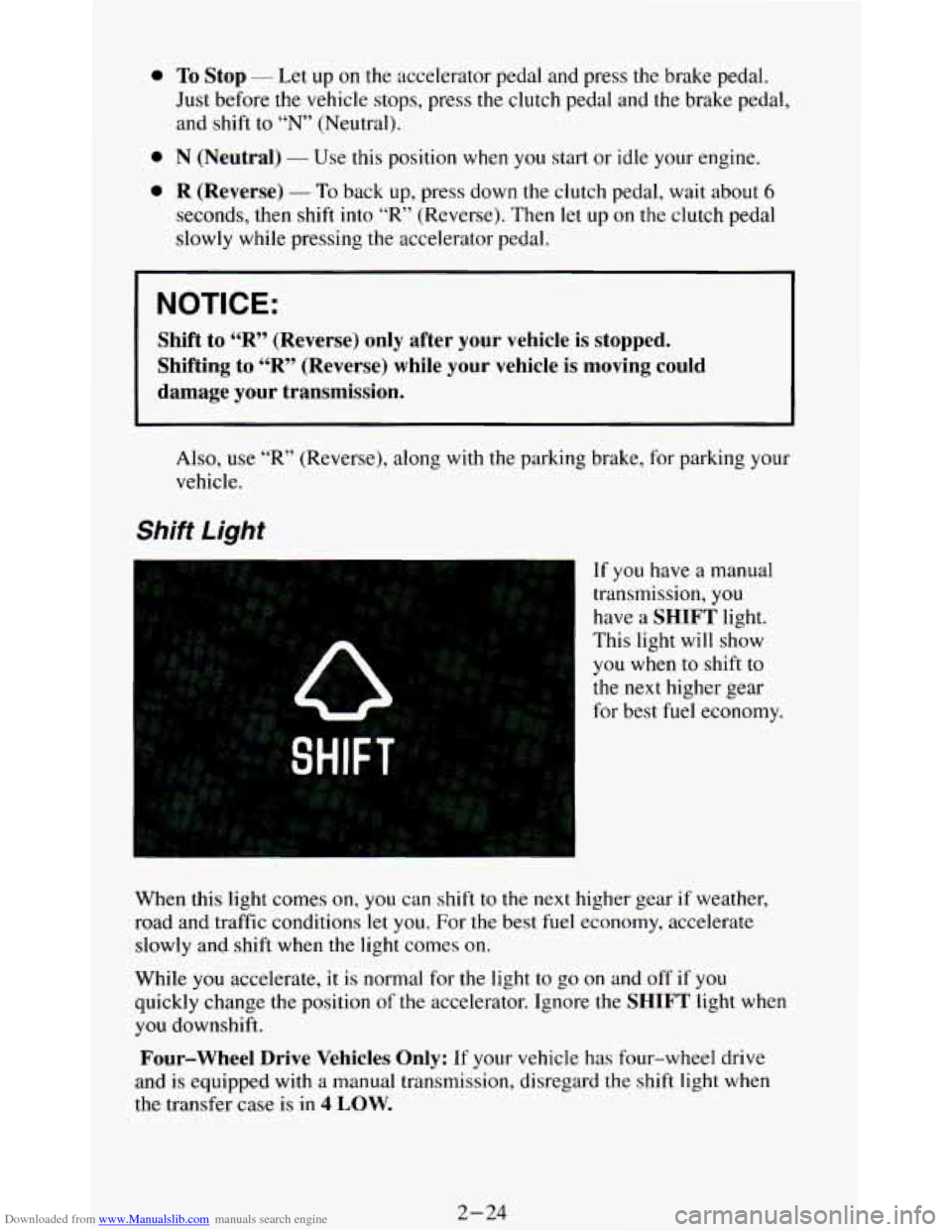
Downloaded from www.Manualslib.com manuals search engine a
0
a
To Stop - Let up on the accelerator pedal and press the brake pedal.
Just before the vehicle stops, press
the clutch pedal and the brake pedal,
and shift to
“N” (Neutral).
N (Neutral) - Use this position when you start or idle your engine.
R (Reverse) - To back up, press down the clutch pedal, wait about 6
seconds, then shift into “R” (Reverse). Then let up on the clutch pedal
slowly while pressing the accelerator pedal.
NOTICE:
Shift to “R” (Reverse) only after your vehicle is stopped.
Shifting to
“R” (Reverse) while your vehicle is moving could
damage your transmission.
Also, use “R’ (Reverse), along with the parking brake, for parking your
vehicle.
Shift Light
If you have a manual
transmission,
you
have a SHIFT light.
This light will show
you when to shift to
the next higher gear
for best fuel economy.
When this light comes
on, you can shift to the next higher gear if weather,
road and traffic conditions
let you. For the best fuel economy, accelerate
slowly and shift when the light comes on.
While
you accelerate, it is normal for the light to go on and off if you
quickly change the position
of the accelerator. Ignore the SHIFT light when
you downshift.
Four-wheel Drive Vehicles Only: If your vehicle has four-wheel drive
and
is equipped with a manual transmission, disregard the shift light when
the transfer case is in
4 LOW.
2-24
Page 79 of 348
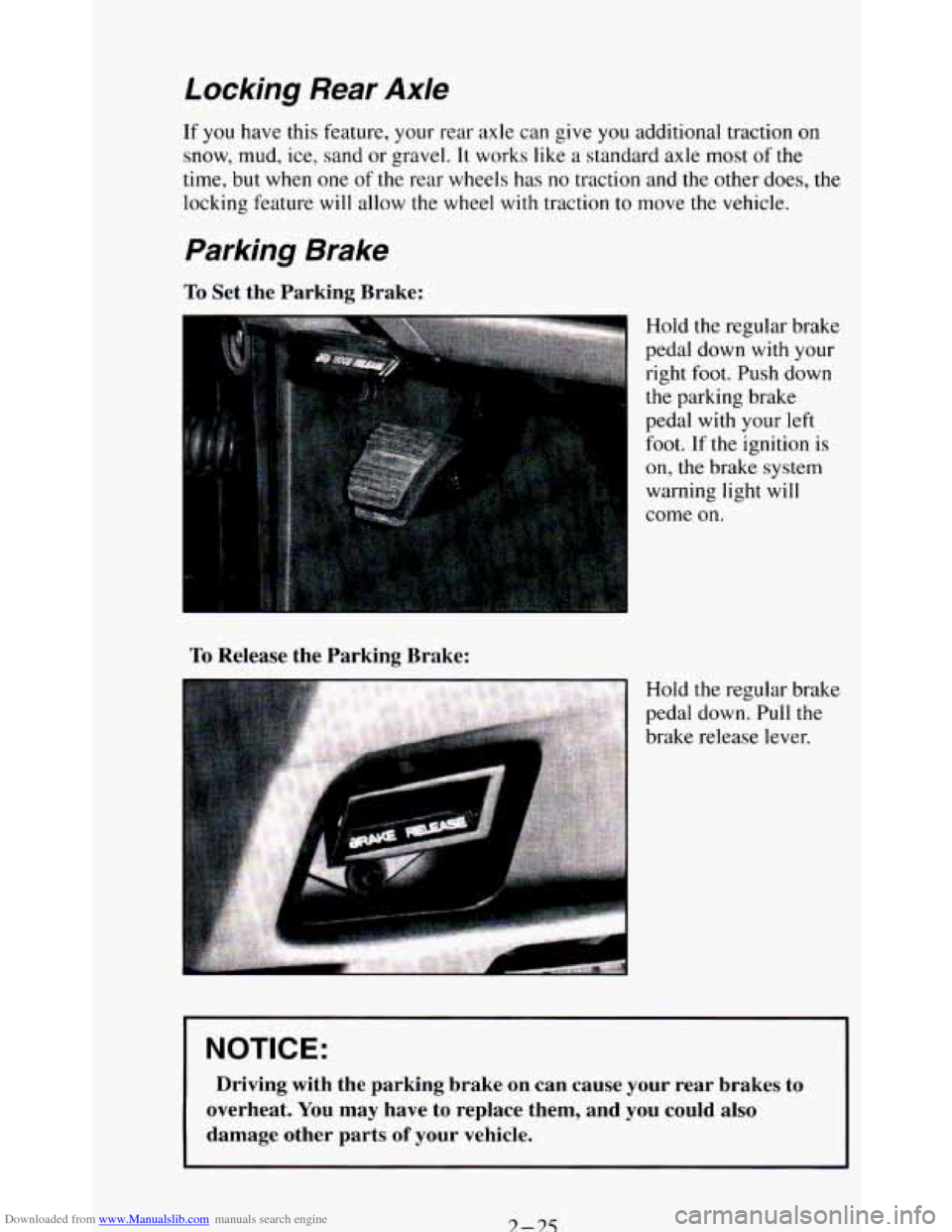
Downloaded from www.Manualslib.com manuals search engine Locking Rear Axle
If you have this feature, your rear axle can give you additional traction on
snow, mud, ice, sand or gravel. It works like a standard axle most of the
time, but when one of the rear wheels has no traction and the other does, the
locking feature will allow the wheel with traction
to move the vehicle.
Parking Brake
-
To Set the Parking Brake:
To Release the Parking Brake:
Hold the regular brake
pedal down
with your
right foot. Push down
the parking brake
pedal with your left
foot. If the ignition is
on, the brake system
warning light will
come
on.
Hold the regular brake
pedal down. Pull the
brake release lever.
I NOTICE: I
Driving with the parking brake on can cause your rear brakes to
overheat.
You may have to replace them, and you could also
damage other parts
of your vehicle.
3 -3.5
Page 80 of 348
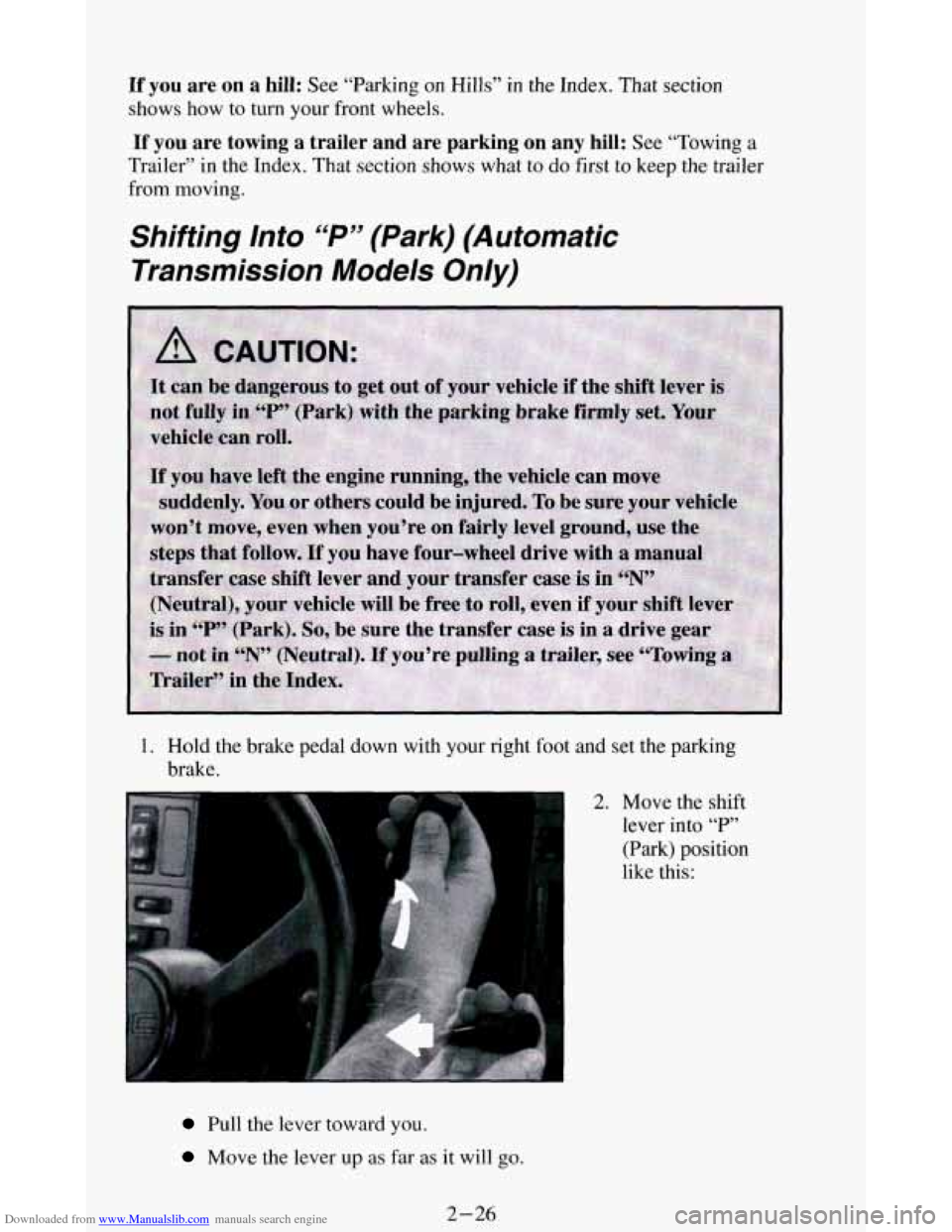
Downloaded from www.Manualslib.com manuals search engine If you are on a hill: See “Parking on Hills” in the Index. That section
shows how to turn your front wheels.
If you are towing a trailer and are parking on any hill: See “Towing a
Trailer” in the Index. That section
shows what to do first to keep the trailer
from moving.
Shifting /nto “P” (Park) (Automatic
Transmission
Models On/y)
1. Hold the brake pedal down with your right foot and set the parking
brake.
2. Move the shift
lever into
“P”
(Park) position
like this:
Pull the lever toward you.
Move the lever up as far as it will go.
2-26